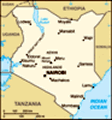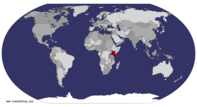Advertisement
Published: March 8th 2011
By James Asudi,
Kibera Slums Tours (A tour of Africa's Second largest slum in Nairobi Kenya) Kibera Slums is ranked the second largest slum is sub Saharan Africa second to Soweto slums in South Africa. The name 'Kibera' is a Nubian word for 'forest.' The original settlers were Sudanese soldiers who settled there after fighting for the British in World War One. The Kibera Slums is located in an area 5 Kilometers South East of City Centre Nairobi. It is the most populated informal settlement in East Africa, housing about one third of Nairobi's population. Kibera is divided into nine official villages, each with its own Village Elder.
They are:
Gatwekera, Kianda, Soweto, Kisumu Ndogo, Lindi, Laini Saba, Siranga/ Undugu, Makina, and Mashimoni. These villages, excludes Raila centre which rest on the northern half of the valley east of the Nairobi Dam.
Kibera is roughly 2.5 Kilometers squared with an estimated population of about 1 million people. There are no permanent residential buildings over a single storey within the slum areas.
(The UN Habitat and the Kenya Government has started the housing Upgrade and have since built several flats for the Kibera residents, although, this project is estimated to take 10 years before completion).
The average home size in Kibera is 3 meters by 3 meters, with an average of five persons per dwelling. Urban services such as water or sanitation are minimal. There is an average of one pit latrine for every 50 to 200 people, save to the new latrines recently built by donors. Eco-toilet Biogas plants are under construction within Kibera Slums which will use human waste as its raw material for the production of gas for both cooking and lighting 200 households once it is fully operational.
Drinking water is sold to the inhabitants in plastic containers after it has been pumped through metal and plastic pipes along side sewage trenches. These trenches carry refuse and human waste to the river at the base of the valley. The river partially runs into Nairobi Dam and also passes the city into the Nairobi River. Both the river and the dam are used for recreation (e.g. swimming) and resource (e.g. bathing; clothes washing). The plastic pipes are brittle and exposed, often breaking, to be repaired without care for sanitation. That is, these pipes are jammed or taped back together often without
being cleaned, creating suitable habitat for water-borne diseases like cholera and typhoid.
Health Services and Sexual Education are minimal in Kibera. There are several individual and NGO run health clinics within the slum .Health mobile clinics are frequently conducted by the health NGO's and the government. Many people living in urban areas in Kenya are either HIV positive or have AIDS.
Housing in Kibera, it is sad to note that many Kibera slum dwellers are tenants to those living within and outside the slums. 90 % of the residents in Kibera are tenants who are not able to pay for their monthly rents regularly. Thanks for the UN - Habitat for constructing the New 600 units at the Kibera decanting site. The construction is underway. Hopefully, the buildings will be occupied by the Kibera residents many of whom cannot pay their rents currently. They are expected to sublet other rooms in order to meet the monthly rent for the new houses once they occupy them. Good luck.
There are few schools within the Kibera slum run by well wishers. These schools are run by donations from individuals and corporate bodies which occasionally donate items like: food, books,
and desks, pens, building materials and teacher's salaries for the volunteer teachers. The case study is the Baraka Za Ibrahim Children Center which is a school offering education to kids as from pre - unit, primary up to secondary level on charitable basis. All activities are run by donations from well wishers. Orphan children are accommodated within the center which also offers boarding facility in tiny iron sheet rooms. A small kitchen is in place for the preparation of lunches and supper. The Classrooms, kitchen, boarding rooms, toilets, staff room, children playing ground are all crowded in an area of about 1 acre of land.
"Imagine that one day you wake up and find that Kibera does not exist and that that the tin roofed mud houses have all been replaced with permanent tiled roofed housing fitted with all basic human amenities including sewerage and sanitary facilities, tarmac roads and it is the same inhabitants of the tin roofed houses occupying the New housing facilities and that Kibera is a New Kibera."
Kibera Slum Tour - 2- 4 Hours (Normal itinerary) Highlights: "This is a 2 - 4 hours excursion Philanthropic / Charity tour of Kibera slums. This tour is recommended for all types of visitors such as business travelers, church missionaries, journalists, and business executives who would like to have a quick feel of slum life in Kenya . It can also be done before or after a normal safari as part of a City Tour. This excursion is famous for those who would like to visit Kibera slums as first time visitors and is available for both the foreigners and the Kenyan populace who have never visited the Kibera Slums or those who will want a repeat of the Kibera Slums visit ". This tour can be done on any day of the week apart from Sunday. If we have any other visitors for this tour on any of these days, then we will have to pair you when need be.
Our Tour Manager together with the Tour Guides plus your Tour Driver will meet you at your hotel or place of residence at 9.00am. Being a Philanthropic / charity tour, you are requested to bring some donations such as clothes (new or second hand), food stuff, school books, pens and sweets or anything that pleases you. Security will be provided during the tour. We expect to have 2 -3 persons walking with you in the slums during this visit.
Itinerary: Kibera Slums Tour - 2 – 4 hours On any day apart from Sunday, we will meet you and brief you about this safari before we start the safari. This is an escorted tour which starts at 9am from your destination/hotel to the city centre and goes through Ngong Road past Uchumi Supermarket, turn left just next to the Nakumatt Supermarket. Pass by the DO headquarters through to Bombolulu stage where you start your tour.
Proceed to Tunza Children's Centre which is an Orphaned Children’s Home. In this home you will be able to see the devastation of HIV / Aids on the slum population and the overcrowding of Orphaned children in a small centre on a 0.01 acre of a plot. Meet Mama Tunza - M/s Timina Khasiala who runs the centre from well wishers' donations.
Visit the Soweto - Power Women Curio (handcrafts) Workshop where you will witness how those living in the Kibera slums are innovative in making ornaments. Proceed to Centre housing the sick and share your moment with these deserving mothers of the slum. Continue with
visits of the Kibera Slums Nursery school at Little Rock . You will then proceed into the real slum past the railway line and pass by to see the Water vender and the Shower shop as you meet other slum dwellers mingling with you as they carry on with their daily chores.
Turn right past the roadside fish mongers into the Biogas toilet, the only one of its kind in Africa which will use human waste as its raw material in the production of Biogas which will be used as cooking gas as well as lighting about 200 households once it is fully functional. Climb to the top roof canteen on this building for a panoramic view of the entire Kibera slums and a photographic session while on top the roof canteen.
Proceed to the Baraka Za Ibrahim School which is a charitable school, run with the donations from well wishers and caters for lower and upper levels of education starting from Nursery to Secondary School level. It has boarding facilities for few Orphaned boys and girls, a small kitchen and a laboratory not to mention a ramshackle over crowded staff room in the centre of this tiny overcrowded
institution.
Proceed to the other homesteads including those of the tour guides and security team members and witness their life styles in the slums. Pass by a popular pub within the slum for a drink, if you so wish, and pass over the bridge unto the Railway line. You may be lucky to witness the train pass on the railway line amidst the tin roofed houses with human beings and animals (goats, dogs, chickens crossing the railway line at the same time).
After your tour, you will return to the vehicle for your trip back to your hotel or residence.
End of Tour
Costs: Enquire at : info@victoriasafaris.com. (Costs depends on the number of participants) Cost Includes: - Transport to Kibera Slums from your hotel / place of residence and back
- Tour guiding fee
- Security team members fee
Cost excludes: - Donations to the project(s) that you may decide
- Tips to the Tour Guides and security group
Advertisement
Tot: 0.088s; Tpl: 0.013s; cc: 7; qc: 23; dbt: 0.0343s; 1; m:domysql w:travelblog (10.17.0.13); sld: 1;
; mem: 1.1mb


























